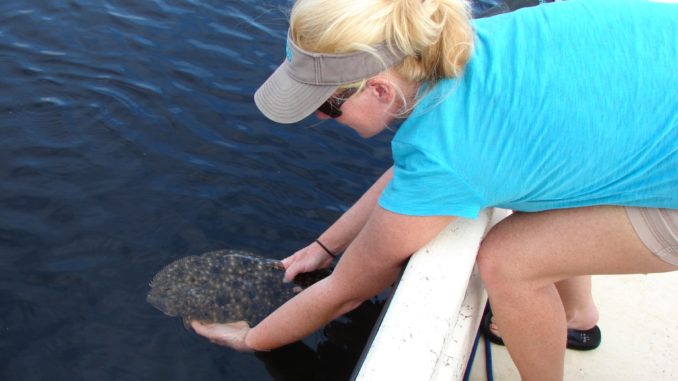
The waters of the lower Cape Fear River and Snow’s Cut have long been known as great places to catch flounder — and large flounder, too. The 20-pound, state-record flounder was caught there in 1980, and though flounder fishing in this area isn’t as good as it once was, it is still the primary location for fishermen trying to catch a flounder 10 pounds or heavier.
The Cape Fear River runs from its origins at Mermaid Point, where the Haw and Deep Rivers join a short distance below the B. Everett Jordan Lake Dam at Moncure, to the coast between Fort Caswell and Bald Head Island. For most of this approximately 200-mile distance, the river is narrow and bordered by bluffs or expansive flood plains. Shortly after the Northeast Cape Fear and Brunswick rivers join it at Wilmington, the Cape Fear gets bigger and is more than a mile wide for the remaining 20 some miles to the ocean.
The Cape Fear is tidal to well above Wilmington, which makes for strong incoming and outgoing tides, especially in and near the ship channel that runs from the ocean upstream to the city. The channel is dredged, and there are spoil islands along it formed with the detritus from the river bottom. These islands interrupt the current and provide shelter for baitfish and shrimp.
Snow’s Cut is a man-made channel carries the Intracoastal Waterway from behind Carolina Beach to the Cape Fear River. Named for Maj. William A. Snow, project manager for the U.S. Army Corps of Engineers for the initial dredging, it is about 1.75 miles long. It was originally dredged to 100 feet wide and 12 feet deep.
While many locals opposed Snow’s Cut and the introduction of more saltwater through Carolina Beach Inlet into the Cape Fear River 10 miles inland, the project was approved and completed. It killed many of the cypress trees lining the river’s banks and changed the marine life along the river from freshwater to brackish species, but the extra exchange of water also brought baitfish through Snow’s Cut with the tides. Larger fish soon followed the baitfish, and inshore saltwater fishing, especially the flounder fishery, flourished.





Be the first to comment